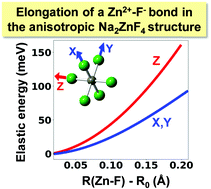当前位置:
X-MOL 学术
›
Phys. Chem. Chem. Phys.
›
论文详情
Our official English website, www.x-mol.net, welcomes your
feedback! (Note: you will need to create a separate account there.)
Local structure and excitations in systems with CuF64− units: lack of Jahn–Teller effect in the low symmetry compound Na2CuF4
Physical Chemistry Chemical Physics ( IF 2.9 ) Pub Date : 2020/03/09 , DOI: 10.1039/c9cp06843k I. Sanchez-Movellan 1, 2, 3, 4 , J. A. Aramburu 1, 2, 3, 4 , M. Moreno 1, 2, 3, 4
Physical Chemistry Chemical Physics ( IF 2.9 ) Pub Date : 2020/03/09 , DOI: 10.1039/c9cp06843k I. Sanchez-Movellan 1, 2, 3, 4 , J. A. Aramburu 1, 2, 3, 4 , M. Moreno 1, 2, 3, 4
Affiliation

|
This work attempts to unveil the similarities and differences between Jahn–Teller (JT) and non-JT systems involving CuF64− units. For achieving this goal, we firstly explore Na2CuF4 and NaF:Cu2+ systems through first principles calculations and pay particular attention to the links between JT and non-JT systems looking at the electronic density of the hole. The results on Na2CuF4 in the monoclinic P21/c space group and also in the parent Pbam structure reveal that the local geometry can be understood as an initial tetragonally compressed CuF64− unit, followed by an additional orthorhombic instability that excludes the JT effect as the origin. Although the present results on NaF:Cu2+ underpin an elongated equilibrium geometry such as that measured for Cu2+ ions in the cubic perovskite KZnF3, the force constant for NaF:Cu2+ is half that for KZnF3:Cu2+. This crucial fact is direct proof of the elastic decoupling of CuF64− from the NaF lattice leading to a JT energy, EJT, which is twice that found for KZnF3:Cu2+. However, both systems have practically the same linear electron–vibration coupling constant, V1e, a relevant fact whose origin is discussed. The final aim of this work concerns the influence of tetragonal and orthorhombic distortions as well as the internal electric field on the A1g–B1g energy gap, Δ, of a variety of systems with CuF64− complexes. Interestingly, it is shown that compounds with orthorhombic instability and an internal electric field can have a Δ value comparable to the JT system NaF:Cu2+. Accordingly, explanations for optical spectra of transition metal compounds based on simple parameterized models can be meaningless. The present study shows that properties displayed by d9 compounds in low symmetry lattices can hardly stem from a static JT effect.
中文翻译:

具有CuF64−单元的系统中的局部结构和激发:低对称化合物Na2CuF4中缺乏Jahn–Teller效应
这项工作试图揭示Jahn–Teller(JT)与涉及CuF 6 4−单元的非JT系统之间的异同。为了实现此目标,我们首先通过第一性原理计算来探索Na 2 CuF 4和NaF:Cu 2+系统,并特别关注JT和非JT系统之间的联系,着眼于空穴的电子密度。Na 2 CuF 4在单斜晶P 2 1 / c空间群以及母体Pbam结构中的结果表明,局部几何形状可以理解为初始四方压缩的CuF 64−单位,其后是附加的正交各向异性不稳定性,将JT效应排除在原点之外。尽管目前关于NaF:Cu 2+的结果支撑了细长的平衡几何结构,例如在立方钙钛矿KZnF 3中对Cu 2+离子的测量,但NaF:Cu 2+的力常数是KZnF 3:Cu 2+的力常数的一半。。这个至关重要的事实直接证明了CuF 6 4−与NaF晶格的弹性解耦导致产生JT能量E JT,这是KZnF 3:Cu 2+的两倍。。但是,两个系统实际上都具有相同的线性电子振动耦合常数V 1e,这是一个有关其起源的相关事实。这项工作的最终目的涉及四方和正交畸变以及内部电场对具有CuF 6 4−配合物的各种系统的A 1g –B 1g能隙Δ的影响。有趣的是,已证明具有正交各向异性和内部电场的化合物的Δ值可与JT系统NaF:Cu 2+相媲美。。因此,基于简单的参数化模型对过渡金属化合物光谱的解释可能毫无意义。本研究表明,d 9化合物在低对称晶格中显示的性质几乎不能源自静态JT效应。
更新日期:2020-04-15
中文翻译:

具有CuF64−单元的系统中的局部结构和激发:低对称化合物Na2CuF4中缺乏Jahn–Teller效应
这项工作试图揭示Jahn–Teller(JT)与涉及CuF 6 4−单元的非JT系统之间的异同。为了实现此目标,我们首先通过第一性原理计算来探索Na 2 CuF 4和NaF:Cu 2+系统,并特别关注JT和非JT系统之间的联系,着眼于空穴的电子密度。Na 2 CuF 4在单斜晶P 2 1 / c空间群以及母体Pbam结构中的结果表明,局部几何形状可以理解为初始四方压缩的CuF 64−单位,其后是附加的正交各向异性不稳定性,将JT效应排除在原点之外。尽管目前关于NaF:Cu 2+的结果支撑了细长的平衡几何结构,例如在立方钙钛矿KZnF 3中对Cu 2+离子的测量,但NaF:Cu 2+的力常数是KZnF 3:Cu 2+的力常数的一半。。这个至关重要的事实直接证明了CuF 6 4−与NaF晶格的弹性解耦导致产生JT能量E JT,这是KZnF 3:Cu 2+的两倍。。但是,两个系统实际上都具有相同的线性电子振动耦合常数V 1e,这是一个有关其起源的相关事实。这项工作的最终目的涉及四方和正交畸变以及内部电场对具有CuF 6 4−配合物的各种系统的A 1g –B 1g能隙Δ的影响。有趣的是,已证明具有正交各向异性和内部电场的化合物的Δ值可与JT系统NaF:Cu 2+相媲美。。因此,基于简单的参数化模型对过渡金属化合物光谱的解释可能毫无意义。本研究表明,d 9化合物在低对称晶格中显示的性质几乎不能源自静态JT效应。











































 京公网安备 11010802027423号
京公网安备 11010802027423号